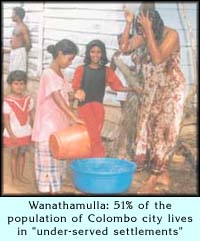 |
 7th March 1999 |
Front Page| |
 Dancing to a different drum |
Contents
|
|
 |
Living on the edgeA millennium plan for Colombo's "under-served settlements"A dynamic team with a vision and an ambitious dream wants to turn the Wanathamulla slums into the Colombo Millennium Township. By Kumudini HettiarachchiFilth, muck and squalor. The stench is unbearable. A mix of cow dung, a polluted canal and odours from common latrines overused by a large number of people. Rows and rows of "homes" resembling chicken coops. Clothes hung all over. "Sili sili" bags strewn in hundreds among other odds and ends, dogs, cattle, cats, rats and of course people. Men, women and children bathing at the roadside taps, collecting water, cooking, eating, playing cards, picking lice off the heads of each other, watching cricket matches on TV or listening to the commentary on radio. It's 2.30 p.m. and on a hot and dusty afternoon we are in the heart of shanty-land. There does not seem to be any other name for Wanathamulla, the hell on earth. Thousands of shanty-dwellers live on this vast old garbage dump heap of the Colombo Municipal Council (CMC) bordered by a green sluggish canal, across which stands the Kolonnawa oil storage tanks. But a few kilometres away, in the old Urban Development Authority (UDA) building on D.R. Wijewardene Mawatha in Fort there is a dynamic team with a vision and an ambitious dream to turn this slumland into the Colombo Millennium Township. Dr. Krishan Deheragoda, Director of the Sustainable Townships Programme (STP) under the Ministry of Housing and Urban Development said their vision is to develop the city of Colombo for the next millennium. But how can it be done when a survey has come up with this shocking statistic: 51% of the population of Colombo city lives in "under-served settlements"? In simple language, "under-served settlements" mean slums and shanties. Of the city's population of around 700,000, more than half - 350,000 - live in sordid conditions without any of the basic amenities. According to Dr. Deheragoda of the total built-up area of the city, 12% is covered by these structures. There are 1,506 such locations or plots, mostly on prime state land. The people are squatters, encroachers or those who have gained illegal access to this land. His team has estimated that there are around 66,000 households living in these squalid environments. The way they estimate it, is fascinating. As many families live under the same roof, officials check how the cooking is done. If the families cook separately, even though they may be using the same kitchen, they consider them as having two budgets and thus put them into the category of two households, a team member explained. Dr. Deheragoda said these under-served communities were living with an element of uncertainty. They had only "conditional" deeds for the tiny hut or shanty they called home. That meant they couldn't sell it or even use it as collateral (surety) to get a small loan. Therefore, they were reluctant to put their savings into improving their homes. On the other hand, the government would need a massive financial commitment to re-house these men, women and children. In the past, big projects such as the poverty alleviation programme (Janasaviya) and Samurdhi had been launched in rural areas where land is not a scarce commodity. Slum and shanty dwellers got some kind of bargaining power with regard to their rights only during an election, he said. The STP Director said similar approaches could not be tried out when dealing with housing issues in the rural and urban sectors. In rural areas, land was not a scarce commodity, only basic resources were sometimes hard to come by. But in a city, it was the reverse. Land was scarce, while basic resources were available. Therefore, the best utilisation of land was an important factor. In a city all activities, housing, commercial etc. should ensure the best land use pattern, Dr. Deheragoda said. Recognising this need, the Colombo Environmental Improvement Project was launched, followed in 1994 by the Clean Settlements Project which has now evolved, taking into consideration the fact that it was not only an environmental problem but also a social one, into the Sustainable Townships Programme. The basic concept of the Clean Settlements Project was to provide on-site upgrading services to those existing slums and shanties. But in 1997, Minister Indika Gunewardene saw Colombo's problem in a different perspective. He advised that the objective be changed to make a "sustainable city", solving the social and environmental problems along with maximum land use. So what could they do with 66,000 families living in highly polluted environments such as canal banks, roadsides, railtracks and also on land reservations on one hand and the dream of promoting Colombo as a commercial and port hub on the other? The answer lay not only in providing housing for the urban poor but also getting valuable land for the development of the city. Stressing that the Sustainable Township Programme was not a political gimmick under which a few houses would be constructed and distributed among party supporters, Dr. Deheragoda said this was a new perspective to develop socially, economically and environmentally sustainable townships. "It is important for us to get the collective acceptance of the settlers or under-served communities for the programme to be a success." "We will not pressurise them only advise and guide them," the STP Director said. What is the difference between STP and other programmes that have already been tried out? According to Dr. Deheragoda, such communities as a group will be made aware of the benefits of STP - the exchange of their plot of land, for which they do not have any ownership rights, for a decent flat in a developed township which would have all amenities. The advantage is that they would have a valid deed in their possession. They would get a voucher for the value of the area they were occupying and would be able to choose from among several housing options suggested by developers. The programme would be self-funding as the land these under-served communities give up will be auctioned and the money utilised to put up the alternative housing units. Of the 1,506 such plots, 495 settlements have been designated at the moment for the programme and the first phase covering seven locations has already been identified. Wanathamulla will be the model and Dr.Deheragoda and his team are hopeful of a "ripple effect" which will lead to all the under-served communities joining up. The seven locations are: -Bakerywatte in Kirula where there are 38 housing units on 307 perches
owned by the UDA At Wanathamulla, 134 acres of state land will be utilised to build a compact township.
-Discussions are on with the education authorities to increase the capacity of schools and also with the railway to set up a station closer to the township. In addition, there will be a commercial area for shops and boutiques, recreational facilities, parking space and a children's playground. Under the pilot phase, 500 housing units in three 10-storey towers will be constructed on an already earmarked 2.3 acres of land at Wanathamulla. Once the flats are constructed, groupings of 300 to 500 owners, who now have deeds, will be guided to form a management company by buying one share for Rs. 25,000 each. These companies will in turn buy electricity and water in bulk and then distribute such facilities to individual members. This will also help them to maintain the building. Will they be able to raise such a lot of money? Yes, assures Dr.Deheragoda's team. It will be an incentive for them to save up that money and be like a down-payment on a permanent home owned by them. They recalled how some of those families had got together and bought a dish antennae at a cost of over Rs. 100,000 to watch cricket matches. "We have to inculcate the savings habit in them," one team member said. Meanwhile, a private limited liability company, Real Estate Exchange (Pvt) Ltd. - REEL — has been floated to play the management role of the STP. REEL comprising the National Housing Development Authority, the UDA, the CMC, the Sri Lanka Land Reclamation and Development Commission and STP, which provides policy guidance, has called on engineering and architectural firms, developers and contractors to participate in the re-housing process.
Longing for a better lifeFor Elinta Elizabeth (44) born in Wanathamulla's '60 watte' the hope of a flat in a township means escape from the tiny 90-square-foot hut she calls home now. She, her husband who is a labourer and their two children, a daughter of 21 and a son of nine, crowd into their tiny home every evening. Cooking a late lunch of rice, dhal and dried prawns in the area she calls her kitchen, and hardly able to turn, she says that her daughter spends the night with her brother's family of six girls. We see why, as she points to a small space between the "hall" and "kitchen" where they sleep. But her home is slightly better off than that of Sriya Kanthi (38) whose "rented" hut is very close to the canal. The two rooms for which they pay their neighbour Rs. 150 a month, are bare except for a few blackened pots and pans in the kitchen. Kanthi who makes a living by packing tea leaves struggles to keep the home fires burning for her four children whose ages range from four to 12. Her husband is a drunk and beats her whenever she refuses to part with her hard-earned money. She too lives in hope of a better life in cleaner surroundings, she smiles, while taking her evening bath at a roadside tap. For K. Susantha who has lived all his life in this "mudukku", life has been relatively good. A railway worker, Susantha's family has lived in Wanathamulla for 50 years. They were from the south, and his father had come to Colombo to work in the harbour and found a home here. He too longs for a better life for his four-year-old daughter. Yes, the township would raise their standard of living, if it was not a political stunt for the forthcoming election, he laughs. These are a few of the families who will benefit from a modern township. Some are still living in the former municipal cattlesheds, where they had been given "temporary" shelter after the flood of 1952.
More Plus * Dancing to a different drum
Front Page| News/Comment| Editorial/Opinion| Business| Sports | Mirror Magazine |
|
 |
Please send your comments and suggestions on this web site to |
|
 And
the dream for Wanathamulla seems ambitious but achievable. About 3,500
families living on the dump itself and 17,500 families living elsewhere
are to be provided brand new flats with water, sanitation, sewerage disposal
facilities, drainage, electricity, telephones and roads.
And
the dream for Wanathamulla seems ambitious but achievable. About 3,500
families living on the dump itself and 17,500 families living elsewhere
are to be provided brand new flats with water, sanitation, sewerage disposal
facilities, drainage, electricity, telephones and roads.